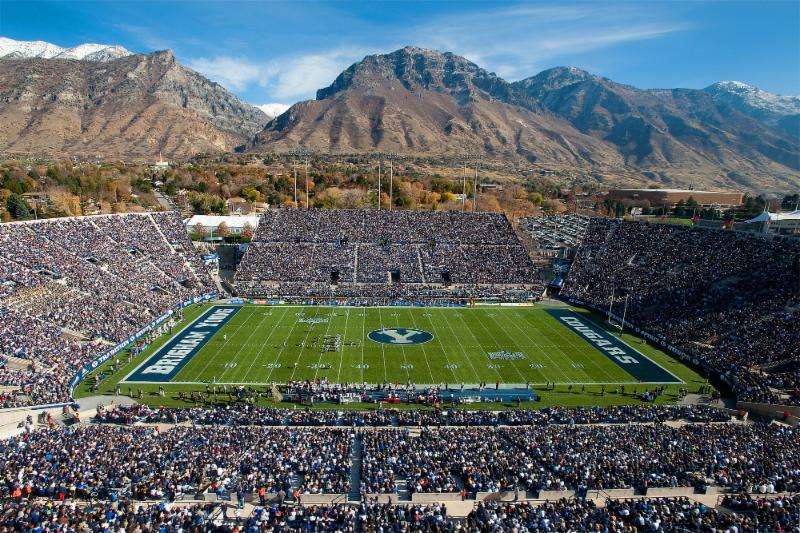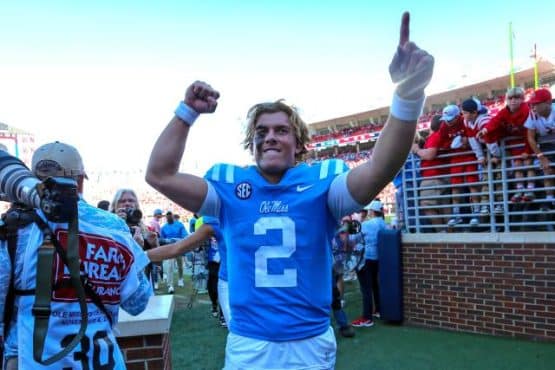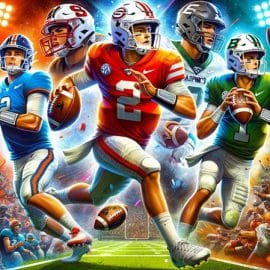There’s a lot of talk about college football realignment doing the rounds lately. With Oklahoma and Texas imminently moving to the SEC, and UCLA and USC leaving the Pac-12 for the Big Ten, we asked ChatGPT how it would like to see the NCAA football conferences realigned.
ChatGPT is useful for a lot of things. It can code, it can help you be more wordy or more succinct, but can it realign college football conferences? We decided to put it to the test. We helped ChatGPT get up-to-date by feeding it information from Wikipedia about the current conferences and impending moves. We then asked ChatGPT how it would go about realigning the college football conferences based on several factors.
ChatGPT Conference Realignment Plan
Below is ChatGPT’s college football realignment manifesto:
Conference realignment in college sports, particularly football, is a complex process driven by a number of factors, such as geography, revenue potential, rivalry considerations, and athletic competitiveness. In this scenario, based on the status of the college football landscape post-2023/24 season, below are my proposed realignments:
Atlantic Coast Conference (ACC):
- Key Points:
- The ACC needs to bolster its football competitiveness to match its prowess in basketball. To that end, adding UCF and West Virginia could strengthen the ACC’s football profile.
- Also, ACC should consider adding Notre Dame as a full member for football. This has long been a point of discussion given Notre Dame’s unique status in college football and its strong competition in the ACC in other sports.
- New Teams: Notre Dame, UCF, West Virginia
- Rationale: UCF and West Virginia would not only add to the football strength but also ensure better regional alignment. Full inclusion of Notre Dame increases the strength of competition and overall brand of ACC.
Big Ten Conference:
- Key Points:
- To strengthen its market presence in the south, the Big Ten could add Georgia Tech and Vanderbilt from the SEC.
- Additionally, Kansas from Big 12 could be a strategic addition considering its strong basketball program.
- New Teams: Georgia Tech, Vanderbilt, Kansas
- Rationale: Adding Georgia Tech and Vanderbilt allows the Big Ten to penetrate the Atlanta and Nashville media markets. Kansas is a historic powerhouse in basketball, which would bring further prestige to the conference.
Southeastern Conference (SEC):
- Key Points:
- The SEC could take advantage of ACC’s instability and attract NC State and Virginia Tech, enhancing its geographical presence up to the Mid-Atlantic region.
- New Teams: NC State, Virginia Tech
- Rationale: NC State and Virginia Tech bring robust football programs to the SEC and their addition would expand the SEC’s footprint into new media markets.
Pac-12 Conference:
- Key Points:
- The Pac-12 could focus on expanding eastwards into the heartland, potentially adding Texas Tech and Oklahoma State from the Big 12.
- BYU could also be a great fit for the conference due to its strong athletic program and religious affiliation, similar to Notre Dame.
- New Teams: Texas Tech, Oklahoma State, BYU
- Rationale: Texas Tech and Oklahoma State would provide a foothold in Texas and Oklahoma markets. BYU brings in strong viewership due to its nationwide following.
Big 12 Conference:
- Key Points:
- The Big 12 can replenish its ranks by adding SMU and Rice from Texas, which would enhance the conference’s presence in the significant Dallas and Houston markets.
- In addition, Colorado State and Boise State from the Mountain West could also be logical additions.
- New Teams: SMU, Rice, Colorado State, Boise State
- Rationale: SMU and Rice help the conference maintain its Texas roots and Colorado State and Boise State have strong football programs to ensure competitive games.
American Athletic Conference:
- Key Points:
- AAC could look at adding Army and Navy, due to their independent status and historic prestige in football.
- Also, Appalachian State and Louisiana Lafayette could be strong additions from the Sun Belt.
- New Teams: Army, Navy, Appalachian State, Louisiana Lafayette
- Rationale: Army and Navy could potentially bring a significant viewership due to their national following, and Appalachian State and Louisiana Lafayette would provide a boost in football competitiveness.
Mountain West Conference:
- Key Points:
- MWC could potentially add North Dakota State, a powerhouse in FCS, and Montana, which has a strong football tradition.
- New Teams: North Dakota State, Montana
- Rationale: Both North Dakota State and Montana have a strong football tradition and could increase the competitiveness of the Mountain West Conference. Also, these teams have substantial fan bases which could be beneficial for the conference’s viewership and overall brand.
Sun Belt Conference:
- Key Points:
- The Sun Belt Conference could add Jacksonville State who have been strong performers in the FCS.
- New Teams: Jacksonville State
- Rationale: This would bolster the conference’s football competitiveness and also increase their regional presence.
Conference USA:
- Key Points:
- Conference USA could potentially add North Alabama and Sam Houston State, who have shown strength in FCS play.
- New Teams: North Alabama, Sam Houston State
- Rationale: The addition of these teams would not only increase the competitiveness of football in the conference but also ensure better regional alignment.
Mid-American Conference (MAC):
- Key Points:
- MAC could potentially add Youngstown State and Northern Iowa to expand its geographical reach and increase football competitiveness.
- New Teams: Youngstown State, Northern Iowa
- Rationale: Both these schools have a strong tradition of competitive football at the FCS level and would strengthen the conference’s overall standing.
Independents:
- Key Points:
- Some teams may choose to go independent. This path would be reasonable for teams with unique situations or those who want to control their scheduling and media rights.
- New Teams: Liberty
- Rationale: Liberty has experienced recent success in football and has substantial financial backing, making it a prime candidate for independence.
Keep in mind that these realignments are hypothetical and based on the situation described. In reality, there are numerous factors, including politics, traditions, and financial considerations, that play crucial roles in conference realignments.
Here is a brief summary of what each conference gains and loses:
- Atlantic Coast Conference (ACC):
- Gains: Notre Dame, UCF, West Virginia
- Loses: NC State, Georgia Tech, Virginia Tech
- Big Ten Conference:
- Gains: Georgia Tech, Vanderbilt, Kansas
- Loses: None
- Southeastern Conference (SEC):
- Gains: NC State, Virginia Tech
- Loses: Vanderbilt
- Pac-12 Conference:
- Gains: Texas Tech, Oklahoma State, BYU
- Loses: None
- Big 12 Conference:
- Gains: SMU, Rice, Colorado State, Boise State
- Loses: West Virginia, Kansas, Texas Tech, Oklahoma State
- American Athletic Conference (AAC):
- Gains: Army, Navy, Appalachian State, Louisiana Lafayette
- Loses: UCF, SMU
- Mountain West Conference (MWC):
- Gains: North Dakota State, Montana
- Loses: Colorado State, Boise State
- Sun Belt Conference:
- Gains: Jacksonville State
- Loses: Appalachian State, Louisiana Lafayette
- Conference USA (C-USA):
- Gains: North Alabama, Sam Houston State
- Loses: Rice
- Mid-American Conference (MAC):
- Gains: Youngstown State, Northern Iowa
- Loses: None
- Independents:
- Gains: Liberty
- Loses: Notre Dame, Army, Navy
TSD Commentary
The big winner under the ChatGPT college football realignment plan would like be the Pac-12. They lose no schools, but gain a couple of college football markets with strong teams in Oklahoma State and Texas Tech.
The Big Ten makes a leap forward on the college basketball front by securing Kansas, but the teams it attracts don’t offer much on the football front with perennial SEC whipping boys Vanderbilt finally jumping ship.
The SEC in true SEC fashion capitalizes on an ACC in turmoil and takes a couple of schools in NC State and Virginia Tech to get a foothold in some new markets. However, the ACC does similar by adding West Virginia and finally makes Notre Dame a full member.
There are wins also for several FCS schools, who make the leap to FBS. These include:
- North Dakota State (Moving to the Mountain West Conference)
- Montana (Moving to the Mountain West Conference)
- Jacksonville State (Moving to the Sun Belt Conference)
- North Alabama (Moving to the Conference USA)
- Sam Houston State (Moving to the Conference USA)
- Youngstown State (Moving to the Mid-American Conference)
- Northern Iowa (Moving to the Mid-American Conference)
That’s a big transition for a lot of schools in a short space of time!
While this AI-generated conference realignment is quite fantastical, it offers a fun and fascinating look at what the future of college football could potentially look like if tradition took a backseat to other factors.
Although such a scenario is unlikely to unfold in reality, envisioning it allows us to appreciate the complex interplay of competition, geography, market considerations, and tradition that shapes the world of college football as we know it.
College Football Betting Guides 2024
- College Football Betting Guide – Best NCAAF Sportsbooks Ranked & Reviewed.
- Free NCAAF Picks – Check out Expert College Football Picks.
- The Latest NCAAF Odds – Compare the Best College Football Odds.
- College Football Moneyline Odds Explained – Learn How To Win NCAAF Moneyline Bets.
- College Football Spreads Explained – Guide on How To Win NCAAF Spreads Bets.
- College Football Futures Odds Explained – Expert Guide on How to Win NCAAF Spread Bets.
- College Football Totals Odds Explained – Guide on How to Win College Football Totals Bets.
Add The Sports Daily to your Google News Feed!







